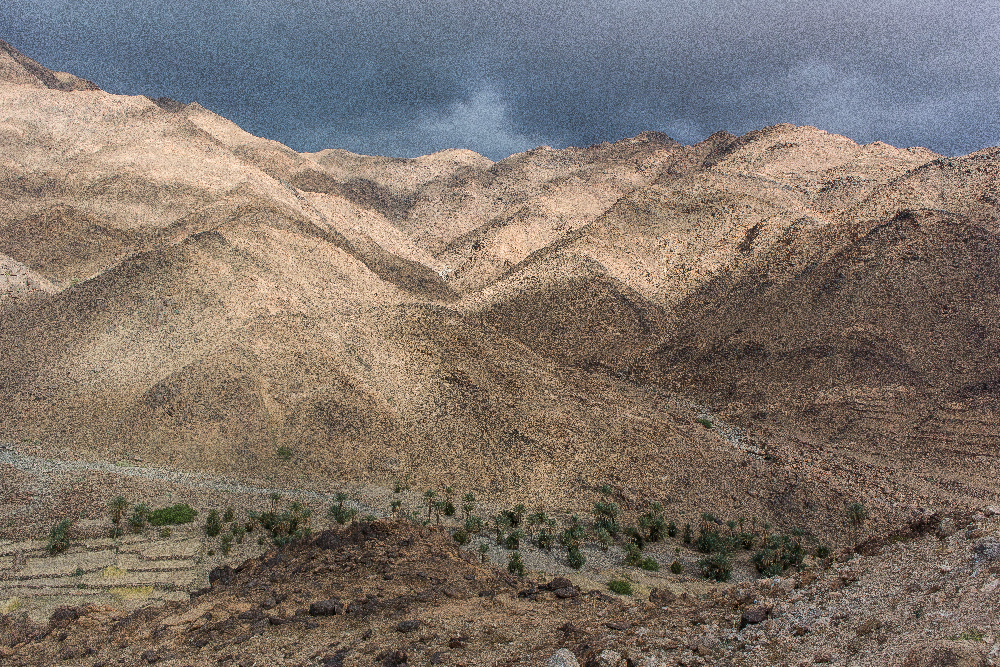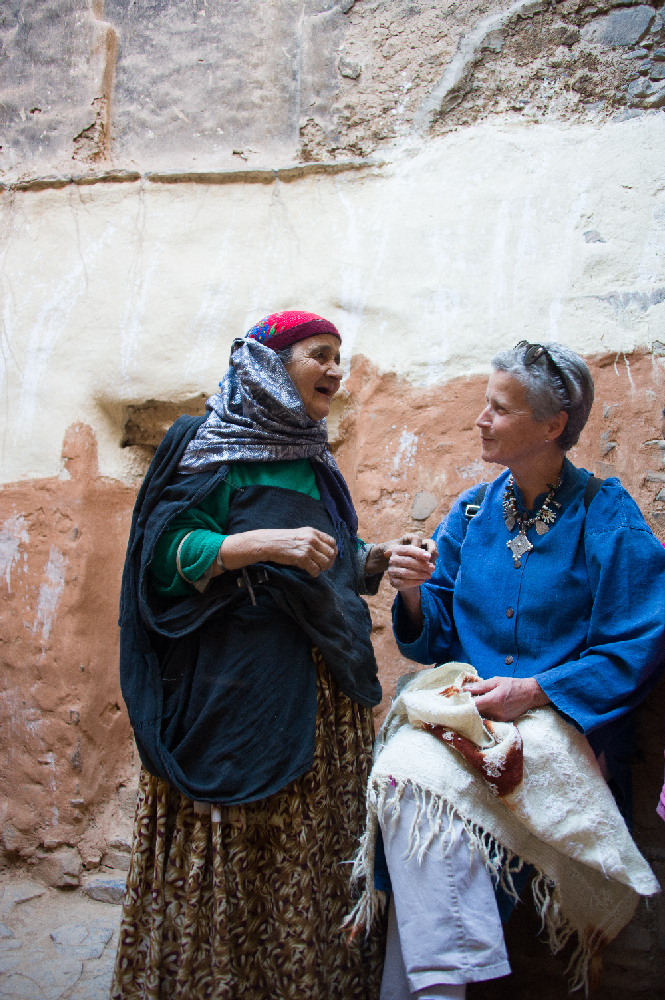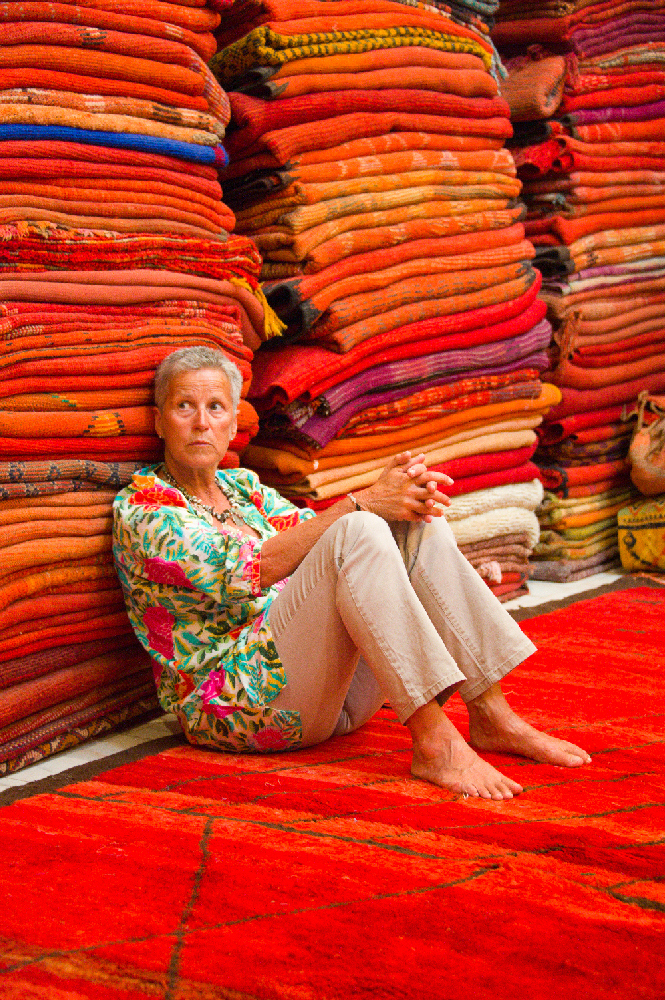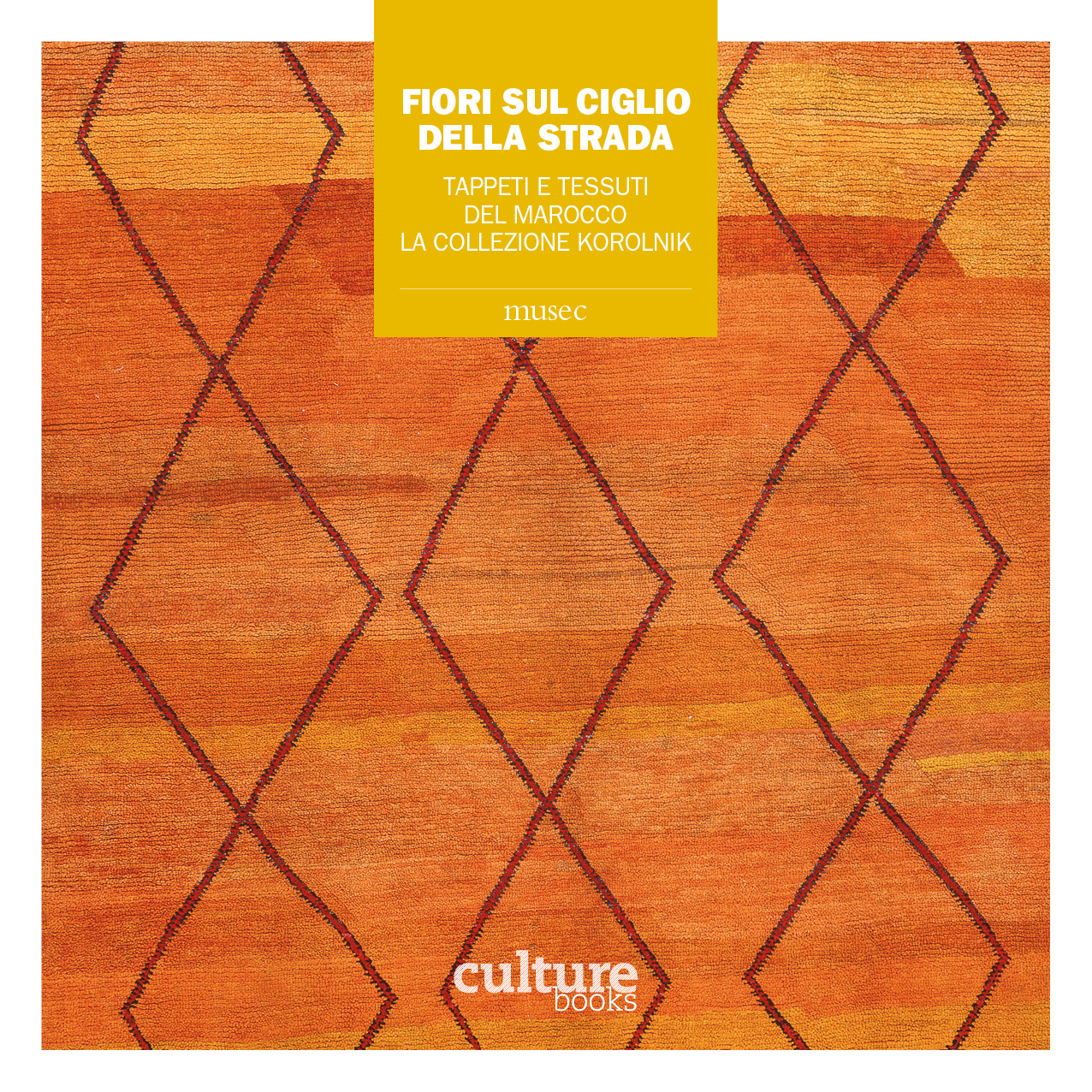Museo delle Culture uses cookies to improve the user experience. If you need more information click on the privacy page. Privacy policy X
11 May 2020 - 10 January 2021, MUSEC, VILLA MALPENSATA, SPAZIO CIELO (THIRD FLOOR)
The temporary exhibition in the Spazio Cielo of Villa Malpensata is dedicated to Annette Korolnik's collection of traditional Moroccan carpets and fabrics.
The project enriches and completes the journey on Morocco, started by MUSEC with the exhibition of impressionist photographs by Roberto Polillo in Spazio Maraini.
In the five rooms on the top floor of Villa Malpensata there are eighteen works on display, mostly of large dimensions: carpets, blankets, shawls and saddle covers, as well as some painted terracottas from Morocco. They are the result of intense and passionate research in the field that Annette Korolnik carried out over thirty years with her husband, Marcel Korolnik, who died in 2008.
The importance of the Korolnik Collection lies both in the quality of the works, precious evidence of Moroccan textile production from the second half of the 19th century to the first half of the 20th century, and in the heterogeneity of the collection, consisting of fabrics and carpets from as many as thirty different ethnic regions of Morocco.
The MUSEC project has the merit of being the first monographic exhibition dedicated to the Korolnik Collection; some of the works from this collection have already been included in textile art exhibitions organized by prestigious international museums including the Musée du quai Branly in Paris, the Museo Nacional Centro de Arte Reina Sofía in Madrid, the Indianapolis Museum of Art and the Museum Bellerive in Zurich.

The textile art of Morocco responds to needs both of a practical nature, due to its concrete use, and of a socio-cultural nature, in relation to the relationships between men. The answer to practical needs is inherent in weaving techniques, in the kind of materials used and in size; characteristics that, combined together, allow textiles to perform one or more functions. "Classic" elements of the textile art are the use of the loom, the hand spun wool purchased in souks or produced at home, the long execution times that could require the presence of even more people. The sociocultural needs, on the other hand, are met by artistic languages with decorations and colours bearing expressive meanings that convey messages inherent to the religious, social, political and economic spheres, giving order to reality in the different areas of human experience. The migrations of peoples and the movements of communities in Northwest Africa over the centuries have brought native Berbers into contact with Arab-Islamic-speaking peoples - the latter having been present in North Africa since the 8th century - have often generated syncretic cultural traditions, grafted onto a common ground. These syncretisms have also concerned the textile field, where the exchange of technical notions and decorations has created elements of contact and overlapping between different ethnic styles. From the decorative point of view, the characteristics of the textile art of the Moroccan people manifest the influence of Islamic art, bent to local customs and traditions. These adaptations were often influenced by the material resources accessible in the territory, especially according to the availability of pigments and natural dyes. The dominant element of the country's textile art is instead the recurrent and abundant use of symmetries, geometric modules, repetitions of simple shapes to build others, combinations of bright colours that emphasize and enhance the geometric games created by the skilled hands of the weaver (a tribute to the meanings and values of tradition). The vivid and evocative chromatic choices of the fabrics, which are the background to "geometric modules" decorations, often compose a poetry of shapes and colours that express the high values of life and the relationship between a people and its environment.

Terraces for the cultivation of wheat in the Valley of Ait Mansour. Anti Atlas. Tata area. 2019. Photo: Annette Korolnik.
An abstract of Paolo Maiullari's interview with Annette Korolnik (published in the exhibition catalogue)
What, in your opinion, is the peculiarity and authenticity of Moroccan textile art?
The peculiarity lies in the variety dictated above all by geographical and climatic conditions: aridity, snow, desert, oasis, seas, plains, plateaus and mountains follow one another continuously, giving rise to changing and fragmented, but often related, anthropic environments. In my opinion, carpets and textiles express more than any other work of art and material culture of Morocco the primary needs of the people who live there, both practical and socio-cultural needs. Looking at the structure and materials of a carpet it is possible to deduce the characteristics of a natural environment, or to trace the migration of a people and the environmental contexts to which this same people had to adapt. The decorative motifs speak instead of identity, roles and relationships between people, syncretism and cultural dynamics in general. The authenticity of textile art lies in the concrete responses given to the fundamental needs of a community's life.
What were you looking for in Morocco?
We were thirsting for freedom and experience beyond the borders of an increasingly anonymous and aseptic world. We were looking for a dimension not disturbed by modernity. We were very much attracted by the Berbers, natives of Morocco, people with a free spirit who do not allow rules to be imposed upon them. Many Berbers still practiced transhumance, they lived part of the year in tents in the mountains and on the highlands, they used what nature offered them, they produced carpets and fabrics to respond to difficult climatic conditions. We perceived their cultural tradition as something archaic and mysterious: little was known about the Berbers, although they had been known to the West for centuries. Saint Augustine was a Berber. Following them in their daily life, we wanted to document and safeguard the authentic aspects of a very ancient cultural tradition for many aspects unknown or misrepresented, but in other aspects still well preserved. So, in the beginning, we looked for Berber carpets, driven by interest, curiosity and desire to discover a reality that still lived according to its own logic. The fabrics produced by women were a magnificent material testimony to the Berber world and its way of working. The Moroccan hinterland, however, is also synonymous with the Arab-Islamic world. As research in the field progressed, we therefore faced this other context.

Annette Korolnik and her friend Aicha talk pleasantly in the shade of a traditional El Feija house. Anti Atlas. Imi n' Tatelt. 2019.
Photo: Alexander Grass.

Annette Korolnik in a souk in Marrakech takes a break during the study and documentation of the carpets of the Haouz Plain. Marrakech, in 2000.
Photo: Marcel Korolnik.
Annette Korolnik-Andersch was born in Bonn on 27 September 1950 and has lived in Ticino since the 1970s. She studied at the School of Arts and Crafts in Zurich and Basel and at Saint Martins College of Art and Design in London, training as a scientific designer and fabric designer. Since the '70s she has been working as a free artist, organizing exhibitions all over Europe.
In the early 1980s, Annette and her husband Marcel Korolnik (1945-2008) travelled to Morocco for the first time and began to engage with Berber peoples and culture. The activity as a collector of carpets and textiles began at the same time.
In 1992, she won an award from the Heinrich Böll Foundation for her artistic activity, which gave her the opportunity to stay three months in Ireland. Since 1993, field research has continued in the Haouz Plain, in the Marrakech area. The following year the Moroccan branch of the Goethe Institut awarded her a scholarship for artist residency in Rabat.
In 1997 she was invited by the Ticino section of the Gesellschaft Schweizer Maler, Bildhauer und Architekten (Gsmba) to the studio in Paris as a resident artist.
From 1998 to 2000 she undertook field research stays in the Anti Atlas, focusing on the almost unexplored textile production of the region.
In 2000, after an intense collaboration with the Parisian institution, she donated an important part of her collection to the Musée du quai Branly - Jacques Chirac.
Since 2008, following the death of her husband Marcel, while continuing her research in the field, she has devoted herself in particular to enhancing the collection and the results of her thirty-year research work in Morocco.
Annette Korolnik and Paolo Maiullari (edited by), Flowers at the road’s edge. Carpets and textiles from Morocco. The Korolnik Collection, Minimalia/2 series, Culture Arts&Books, Lugano 2020, pp. 144, ISBN 9788894477511. CHF 32.
Summary
Preface by Francesco Paolo Campione.
A word from the art collector. The Morocco of Annette Korolnik by Paolo Maiullari
Cartography
Works
- Ancient imperial cities. Rabat, Salé and the interaction with the territory
- In search of prosperity. Migrations and nomadism in the Atlas Mountains
- A poetry of geometries and colours. Art and peoples of the Middle Atlas Mountains
- Water and fire. Monumental carpets of the plains of Marrakech
- Lands of dormant volcanoes. Siroua and Anti Atlas
- Bou itri: the starry sky at the edge of the desert. Fabrics painted with henna
Biobibliography of Annette Korolnik by Moira Luraschi
Technical glossary by Nicola Castelletti
Reference bibliography by Stefano Boumya and Bianka Pabst
"Minimalia" is an easy-to-use hard cover booklet, designed to highlight the images of the works exhibited by MUSEC, or to create elegantly illustrated volumes that can deepen, with a simple and clear language, the themes of the activities carried out by the Museum. The editorial structure of the series is particularly aimed at presenting the history and the human story of collectors, artists and protagonists of the world of culture; at documenting work in progress; at restoring the meaning and value of the work of artists in residence, and at making the small and large events in art and culture easily understandable to the general public.

Dates
11 May - 11 October 2020
Timetables
Every day from 11AM to 6PM, Closed on Tuesdays.